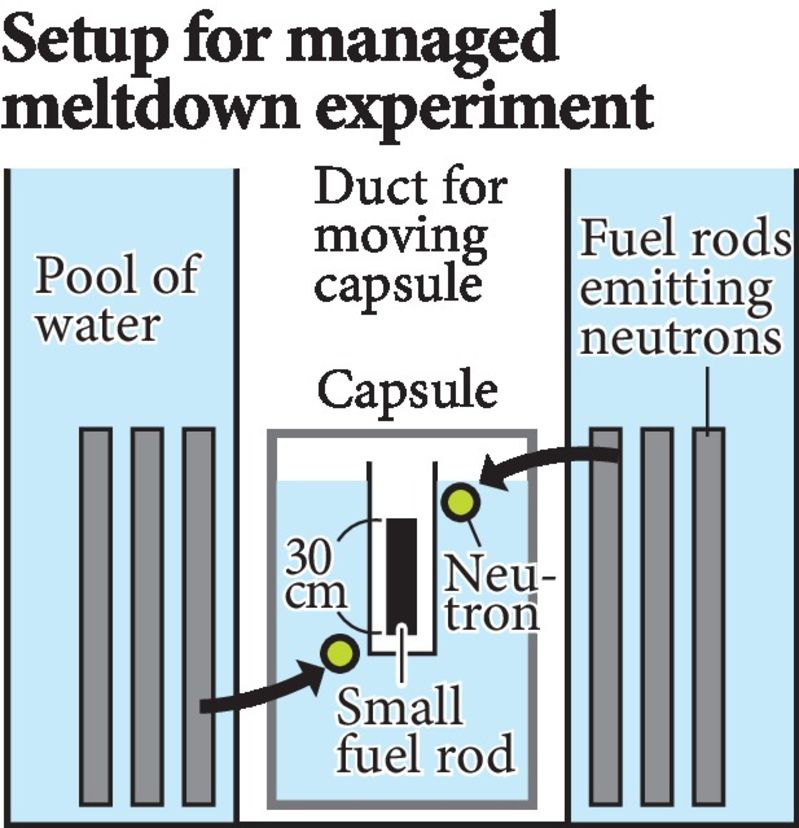It looks like you're using an Ad Blocker.
Please white-list or disable AboveTopSecret.com in your ad-blocking tool.
Thank you.
Some features of ATS will be disabled while you continue to use an ad-blocker.
share:
reply to post by Sremmos80
Okay.... I don't see how it's relevant though....
I didn't answer it because it's a stupid question.
A meltdown is when the cooling system of a nuclear reactor goes offline, and the heat of the reaction begins building up to a point where the fuel rods MELT
If it is done on purpose, it's not an accident.
If you know it's going to happen, and have specifically constructed the reactor to CONTAIN the molten radionucleotides, then it isn't uncontrollable.
IT's not an oxymoron, because a meltdown describes the fuel MELTING DOWN.
Typically, this is not what you want, and is accidental.
This by no means precludes the purposefull melting down of nuclear fuels.
Nor does it preclude this being done in a controlled manner.
Your contention is specious, and merely semantic....
And it's not semantic in the good way of "Understanding what the words we are using mean"
It's semantic in the way that you are totally missing the entire point of the meaning of the term, by injecting meaning that isn't there, or is irrelevant to the discussion.
en.wikipedia.org...
The correct technical term is a "Partial core melt", or perhapse "Total core melt"
However, Meltdown (As the words that comprise this compound word indicate) merely means "To Melt"
We have, plenty of times, as a species, melted things....
On purpose, mind you.
So I don't really see why you are insisting that a Controlled Nuclear Fuel Meltdown is an oxymoron.
Why not post the whole quote
Okay.... I don't see how it's relevant though....
So you think a meltdown can be controlled? Because thats where the idea of it being a oxymoron comes form, trying to control something that is an accident to begin with...
you didn't even answer the question I asked you so why should I answer yours?
So you think a meltdown can be controlled?
I didn't answer it because it's a stupid question.
A meltdown is when the cooling system of a nuclear reactor goes offline, and the heat of the reaction begins building up to a point where the fuel rods MELT
If it is done on purpose, it's not an accident.
If you know it's going to happen, and have specifically constructed the reactor to CONTAIN the molten radionucleotides, then it isn't uncontrollable.
is that a "controlled meltdown" is an oxymoron.
IT's not an oxymoron, because a meltdown describes the fuel MELTING DOWN.
Typically, this is not what you want, and is accidental.
This by no means precludes the purposefull melting down of nuclear fuels.
Nor does it preclude this being done in a controlled manner.
Your contention is specious, and merely semantic....
And it's not semantic in the good way of "Understanding what the words we are using mean"
It's semantic in the way that you are totally missing the entire point of the meaning of the term, by injecting meaning that isn't there, or is irrelevant to the discussion.
en.wikipedia.org...
Nuclear meltdown is an informal term for a severe nuclear reactor accident that results in core damage from overheating. The term is not officially defined by the International Atomic Energy Agency[2] or by the U.S. Nuclear Regulatory Commission.[3] However, it has been defined to mean the accidental melting of the core of a nuclear reactor,[4] and is in common usage a reference to the core's either complete or partial collapse. "Core melt accident" and "partial core melt"[5] are the analogous technical terms for a meltdown.
The correct technical term is a "Partial core melt", or perhapse "Total core melt"
However, Meltdown (As the words that comprise this compound word indicate) merely means "To Melt"
We have, plenty of times, as a species, melted things....
On purpose, mind you.
So I don't really see why you are insisting that a Controlled Nuclear Fuel Meltdown is an oxymoron.
edit on E7Sun, 12 Jan 2014 20:31:31
-060080America/ChicagoAmerica/Chicago by ENrgLee because: clarification
Agency plans to re-create ‘meltdown’
Source

The experiment will be conducted at the Nuclear Safety Research Reactor in Tokai, Ibaraki Prefecture. A 1.2-meter-long stainless steel capsule containing a 30-centimeter-long fuel rod will be placed at the core of the reactor in such a way that the coolant water does not come into contact with the rod. Neutrons emitted by fuel surrounding the capsule will facilitate nuclear fission in the small fuel rod, which will begin melting after its temperature reaches 2,000 C.
According to the agency, the fuel rod, much smaller than the bundles of 4.5-meter-long rods used in the plant’s actual operation, will shortly cease its fission process and start to cool down. It will return to a solid state in several minutes. The solidified fuel will be analyzed before being stored in a pool with other spent nuclear fuel rods.
Source

new topics
-
New Disney Star Wars Films Failing Test of Time?
Movies: 7 hours ago -
The Cost of True Discipleship—Count the Cost
Religion, Faith, And Theology: 11 hours ago
